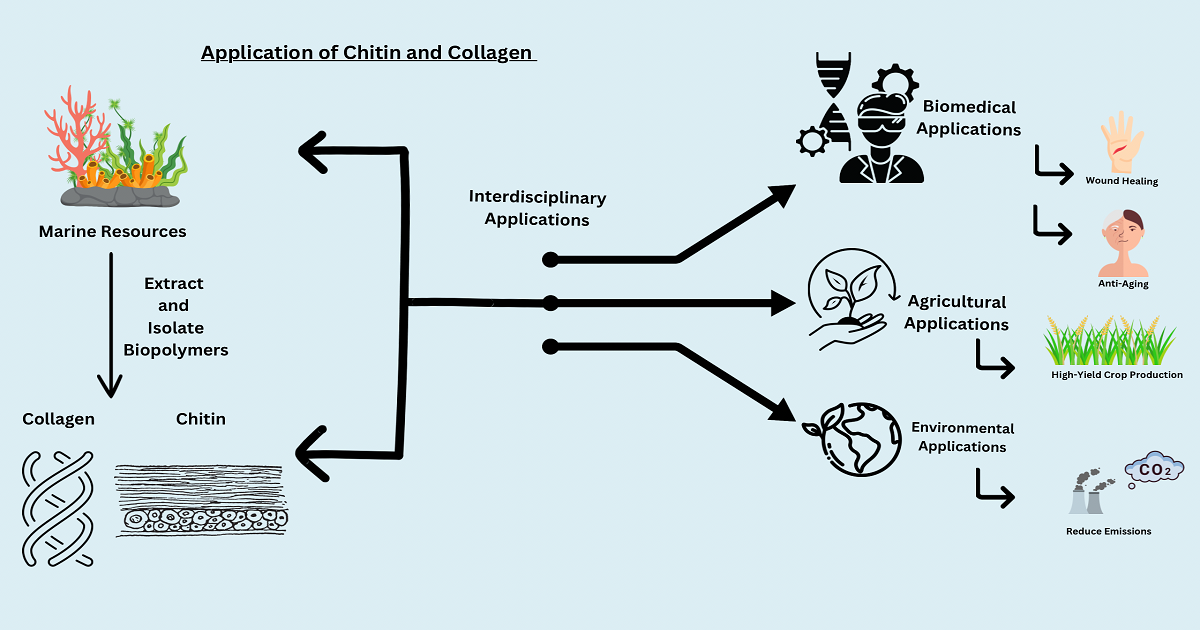Collagen and Chitin from Marine Resources and Their Interdisciplinary Applications—2nd Edition
A special issue of Marine Drugs (ISSN 1660-3397). This special issue belongs to the section "Biomaterials of Marine Origin".
Deadline for manuscript submissions: closed (30 September 2025) | Viewed by 7635

Special Issue Editor
Interests: marine collagen; marine chitin; chitosan; marine proteins; marine polysaccharides; drug discovery; biomineralization; biomaterials; marine invertebrates; corals; marine algae; marine fish proteomics; marine biotechnology
Special Issues, Collections and Topics in MDPI journals
Special Issue Information
Dear Colleagues,
Following the success of the first edition this Special Issue, “Collagen and Chitin from Marine Resources and Their Interdisciplinary Applications”, we are delighted to announce its second edition.
Marine collagen and chitin have great potential applications in drug discovery, drug delivery, wound healing, tissue engineering, antiaging, agriculture, and environmental fields. These two biopolymers also exhibit similar hierarchical structural organizations. After cellulose, chitin is the world's second-most important natural polymer and has been identified in bacteria, fungi, plants, and marine invertebrates. Chitin can also be enzymatically deacetylated to chitosan, a more flexible and soluble biopolymer. As mentioned above, it has many applications, including in the biomedical, environmental, and agricultural sectors. Similarly, nature is a source of massive quantities of collagen, especially in marine organisms. Collagen is the main fibrous structural protein in animals' extracellular matrix and connective tissue. It contributes greatly to biotechnology products and medical applications.
As the Guest Editor of this Special Issue, I would like to invite you to submit recent innovations for these two biopolymers, including original studies, reviews, short communications, and innovations in biological sources and their promising applications.
Dr. Azizur Rahman
Guest Editor
Manuscript Submission Information
Manuscripts should be submitted online at www.mdpi.com by registering and logging in to this website. Once you are registered, click here to go to the submission form. Manuscripts can be submitted until the deadline. All submissions that pass pre-check are peer-reviewed. Accepted papers will be published continuously in the journal (as soon as accepted) and will be listed together on the special issue website. Research articles, review articles as well as short communications are invited. For planned papers, a title and short abstract (about 100 words) can be sent to the Editorial Office for announcement on this website.
Submitted manuscripts should not have been published previously, nor be under consideration for publication elsewhere (except conference proceedings papers). All manuscripts are thoroughly refereed through a single-blind peer-review process. A guide for authors and other relevant information for submission of manuscripts is available on the Instructions for Authors page. Marine Drugs is an international peer-reviewed open access monthly journal published by MDPI.
Please visit the Instructions for Authors page before submitting a manuscript. The Article Processing Charge (APC) for publication in this open access journal is 2900 CHF (Swiss Francs). Submitted papers should be well formatted and use good English. Authors may use MDPI's English editing service prior to publication or during author revisions.
Keywords
- marine collagen
- marine chitin
- chitosan
- marine proteins and peptides
- biopolymers
- corals
- sponges
- sea urchins
- marine fish
- mollusks/bivalves
- marine algae
- marine polysaccharides
- marine bioactive compounds
- marine biotechnology
- marine biomaterials
- proteomics
Benefits of Publishing in a Special Issue
- Ease of navigation: Grouping papers by topic helps scholars navigate broad scope journals more efficiently.
- Greater discoverability: Special Issues support the reach and impact of scientific research. Articles in Special Issues are more discoverable and cited more frequently.
- Expansion of research network: Special Issues facilitate connections among authors, fostering scientific collaborations.
- External promotion: Articles in Special Issues are often promoted through the journal's social media, increasing their visibility.
- Reprint: MDPI Books provides the opportunity to republish successful Special Issues in book format, both online and in print.
Further information on MDPI's Special Issue policies can be found here.
Related Special Issues
- Collagen from Marine Biological Source and Medical Applications in Marine Drugs (19 articles)
- Marine Skeletal Biopolymers and Proteins, and Their Biomedical Application in Marine Drugs (14 articles)
- Marine Skeletal Biopolymers and Proteins 2 in Marine Drugs (4 articles)
- Advances in Marine Chitin and Chitosan in Marine Drugs (20 articles)
- Advances in Marine Chitin and Chitosan II, 2017 in Marine Drugs (25 articles)
- Marine Chitin 2019 in Marine Drugs (16 articles)
- Fundamentals and Biomedical Applications of Marine Collagen in Marine Drugs (8 articles)
- Collagen and Chitin from Marine Resources and Their Interdisciplinary Applications in Marine Drugs (14 articles)
- Application of Marine Chitin and Chitosan II in Marine Drugs (5 articles)
- Application of Marine Chitin and Chitosan in Marine Drugs (13 articles)






